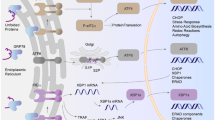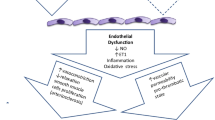Abstract
Hypertensive cerebropathy is a pathological condition associated with cerebral edema and disruption of the blood–brain barrier. However, the molecular pathways leading to this condition remains obscure. We hypothesize that MMP-9 inhibition can help reducing blood pressure and endothelial disruption associated with hypertensive cerebropathy. Dahl salt-sensitive (Dahl/SS) and Lewis rats were fed with high-salt diet for 6 weeks and then treated without and with GM6001 (MMP inhibitor). Treatment of GM6001 (1.2 mg/kg body weight) was administered through intraperitoneal injections on alternate days for 4 weeks. GM6001 non-administered groups were given vehicle (0.9 % NaCl in water) treatment as control. Blood pressure was measured by tail-cuff method. The brain tissues were analyzed for oxidative/nitrosative stress, vascular MMP-9 expression, and tight junction proteins (TJPs). GM6001 treatment significantly reduced mean blood pressure in Dahl/SS rats which was significantly higher in vehicle-treated Dahl/SS rats. MMP-9 expression and activity was also considerably reduced in GM6001-treated Dahl/SS rats, which was otherwise notably increased in vehicle-treated Dahl/SS rats. Similarly MMP-9 expression in cerebral vessels of GM6001-treated Dahl/SS rats was also alleviated, as devised by immunohistochemistry analysis. Oxidative/nitrosative stress was significantly higher in vehicle-treated Dahl/SS rats as determined by biochemical estimations of malondialdehyde, nitrite, reactive oxygen species, and glutathione levels. RT-PCR and immunohistochemistry analysis further confirmed considerable alterations of TJPs in hypertensive rats. Interestingly, GM6001 treatment significantly ameliorated oxidative/nitrosative stress and TJPs, which suggest restoration of vascular integrity in Dahl/SS rats. These findings determined that pharmacological inhibition of MMP-9 in hypertensive Dahl-SS rats attenuate high blood pressure and hypertension-associated cerebrovascular pathology.







Similar content being viewed by others
References
Gorelick PB (2002) New horizons for stroke prevention: PROGRESS and HOPE. Lancet Neurol 1:149–156
Freis ED (1992) The role of salt in hypertension. Blood Press 1:196–200
Swales JD (1992) Salt and blood pressure. Blood Press 1:201–204
Meneely GR, Ball CO (1958) Experimental epidemiology of chronic sodium chloride toxicity and the protective effect of potassium chloride. Am J Med 25:713–725
Kawasaki T, Delea CS, Bartter FC, Smith H (1978) The effect of high-sodium and low-sodium intakes on blood pressure and other related variables in human subjects with idiopathic hypertension. Am J Med 64:193–198
Weinberger MH (1996) Salt sensitivity of blood pressure in humans. Hypertension 27:481–490
Cecchelli R, Berezowski V, Lundquist S, Culot M, Renftel M, Dehouck MP, Fenart L (2007) Modelling of the blood-brain barrier in drug discovery and development. Nat Rev Drug Discov 6:650–661. doi:10.1038/nrd2368
Hawkins BT, Davis TP (2005) The blood-brain barrier/neurovascular unit in health and disease. Pharmacol Rev 57:173–185. doi:10.1124/pr.57.2.4
Mark KS, Davis TP (2002) Cerebral microvascular changes in permeability and tight junctions induced by hypoxia-reoxygenation. Am J Physiol Heart Circ Physiol 282:H1485–H1494. doi:10.1152/ajpheart.00645.2001
Baumbach GL, Heistad DD (1988) Cerebral circulation in chronic arterial hypertension. Hypertension 12:89–95
Sternlicht MD, Werb Z (2001) How matrix metalloproteinases regulate cell behavior. Annu Rev Cell Dev Biol 17:463–516. doi:10.1146/annurev.cellbio.17.1.463
Cauwe B, Van den Steen PE, Opdenakker G (2007) The biochemical, biological, and pathological kaleidoscope of cell surface substrates processed by matrix metalloproteinases. Crit Rev Biochem Mol Biol 42:113–185. doi:10.1080/10409230701340019
Flamant M, Placier S, Dubroca C, Esposito B, Lopes I, Chatziantoniou C, Tedgui A, Dussaule JC, Lehoux S (2007) Role of matrix metalloproteinases in early hypertensive vascular remodeling. Hypertension 50:212–218. doi:10.1161/HYPERTENSIONAHA.107.089631
Kalani A, Kamat PK, Chaturvedi P, Tyagi SC, Tyagi N (2014) Curcumin-primed exosomes mitigate endothelial cell dysfunction during hyperhomocysteinemia. Life Sci 107:1–7. doi:10.1016/j.lfs.2014.04.018
Kalani A, Kamat PK, Familtseva A, Chaturvedi P, Muradashvili N, Narayanan N, Tyagi SC, Tyagi N (2014) Role of microRNA29b in blood-brain barrier dysfunction during hyperhomocysteinemia: an epigenetic mechanism. J Cereb Blood Flow Metab 34:1212–1222. doi:10.1038/jcbfm.2014.74
Rosell A, Ortega-Aznar A, Alvarez-Sabin J, Fernandez-Cadenas I, Ribo M, Molina CA, Lo EH, Montaner J (2006) Increased brain expression of matrix metalloproteinase-9 after ischemic and hemorrhagic human stroke. Stroke 37:1399–1406. doi:10.1161/01.STR.0000223001.06264.af
Kalani A, Kamat PK, Givvimani S, Brown K, Metreveli N, Tyagi SC, Tyagi N (2014) Nutri-epigenetics ameliorates blood-brain barrier damage and neurodegeneration in hyperhomocysteinemia: role of folic acid. J Mol Neurosci 52:202–215. doi:10.1007/s12031-013-0122-5
Lominadze D, Roberts AM, Tyagi N, Moshal KS, Tyagi SC (2006) Homocysteine causes cerebrovascular leakage in mice. Am J Physiol Heart Circ Physiol 290:H1206–H1213. doi:10.1152/ajpheart.00376.2005
Chen F, Ohashi N, Li W, Eckman C, Nguyen JH (2009) Disruptions of occludin and claudin-5 in brain endothelial cells in vitro and in brains of mice with acute liver failure. Hepatology 50:1914–1923. doi:10.1002/hep.23203
Muradashvili N, Tyagi R, Metreveli N, Tyagi SC, Lominadze D (2014) Ablation of MMP9 gene ameliorates paracellular permeability and fibrinogen-amyloid beta complex formation during hyperhomocysteinemia. J Cereb Blood Flow Metab 34:1472–1482. doi:10.1038/jcbfm.2014.102
Pushpakumar SB, Kundu S, Metreveli N, Tyagi SC, Sen U (2013) Matrix metalloproteinase inhibition mitigates renovascular remodeling in salt-sensitive hypertension. Physiol Rep 1:e00063. doi:10.1002/phy2.63
Kamat PK, Tota S, Saxena G, Shukla R, Nath C (2010) Okadaic acid (ICV) induced memory impairment in rats: a suitable experimental model to test anti-dementia activity. Brain Res 1309:66–74. doi:10.1016/j.brainres.2009.10.064
Iwai J, Heine M (1986) Dahl salt-sensitive rats and human essential hypertension. J Hypertens Suppl 4:S29–S31
Rapp JP (1982) Dahl salt-susceptible and salt-resistant rats. A review. Hypertension 4:753–763
Bright R, Steinberg GK, Mochly-Rosen D (2007) DeltaPKC mediates microcerebrovascular dysfunction in acute ischemia and in chronic hypertensive stress in vivo. Brain Res 1144:146–155. doi:10.1016/j.brainres.2007.01.113
Zozulya AL, Reinke E, Baiu DC, Karman J, Sandor M, Fabry Z (2007) Dendritic cell transmigration through brain microvessel endothelium is regulated by MIP-1alpha chemokine and matrix metalloproteinases. J Immunol 178:520–529
Wang J, Tsirka SE (2005) Neuroprotection by inhibition of matrix metalloproteinases in a mouse model of intracerebral haemorrhage. Brain 128:1622–1633. doi:10.1093/brain/awh489
Tasaki A, Shimizu F, Sano Y, Fujisawa M, Takahashi T, Haruki H, Abe M, Koga M, Kanda T (2014) Autocrine MMP-2/9 secretion increases the BBB permeability in neuromyelitis optica. J Neurol Neurosurg Psychiatry 85:419–430. doi:10.1136/jnnp-2013-305907
Fingleton B (2007) Matrix metalloproteinases as valid clinical targets. Curr Pharm Des 13:333–346
Cui J, Chen S, Zhang C, Meng F, Wu W, Hu R, Hadass O, Lehmidi T, Blair GJ, Lee M, Chang M, Mobashery S, Sun GY, Gu Z (2012) Inhibition of MMP-9 by a selective gelatinase inhibitor protects neurovasculature from embolic focal cerebral ischemia. Mol Neurodegener 7:21. doi:10.1186/1750-1326-7-21
Iadecola C, Davisson RL (2008) Hypertension and cerebrovascular dysfunction. Cell Metab 7:476–484. doi:10.1016/j.cmet.2008.03.010
Tyagi N, Gillespie W, Vacek JC, Sen U, Tyagi SC, Lominadze D (2009) Activation of GABA-A receptor ameliorates homocysteine-induced MMP-9 activation by ERK pathway. J Cell Physiol 220:257–266. doi:10.1002/jcp.21757
Tyagi N, Qipshidze N, Munjal C, Vacek JC, Metreveli N, Givvimani S, Tyagi SC (2012) Tetrahydrocurcumin ameliorates homocysteinylated cytochrome-c mediated autophagy in hyperhomocysteinemia mice after cerebral ischemia. J Mol Neurosci 47:128–138. doi:10.1007/s12031-011-9695-z
Gasche Y, Copin JC, Sugawara T, Fujimura M, Chan PH (2001) Matrix metalloproteinase inhibition prevents oxidative stress-associated blood-brain barrier disruption after transient focal cerebral ischemia. J Cereb Blood Flow Metab 21:1393–1400. doi:10.1097/00004647-200112000-00003
Reinhard SM, Razak K, Ethell IM (2015) A delicate balance: role of MMP-9 in brain development and pathophysiology of neurodevelopmental disorders. Front Cell Neurosci 9:280. doi:10.3389/fncel.2015.00280
Kim SC, Singh M, Huang J, Prestigiacomo CJ, Winfree CJ, Solomon RA, Connolly ES Jr (1997) Matrix metalloproteinase-9 in cerebral aneurysms. Neurosurgery 41:642–666 (discussion 646-7)
Jickling GC, Liu D, Stamova B, Ander BP, Zhan X, Lu A, Sharp FR (2014) Hemorrhagic transformation after ischemic stroke in animals and humans. J Cereb Blood Flow Metab 34:185–199. doi:10.1038/jcbfm.2013.203
Kalani A, Kamat PK, Tyagi N (2015) Diabetic stroke severity: epigenetic remodeling and Neuro-glio-vascular dysfunction. Diabetes. doi:10.2337/db15-0422
Touyz RM (2006) Mitochondrial redox control of matrix metalloproteinase signaling in resistance arteries. Arterioscler Thromb Vasc Biol 26:685–688. doi:10.1161/01.ATV.0000216428.90962.60
Garcia-Alloza M, Prada C, Lattarulo C, Fine S, Borrelli LA, Betensky R, Greenberg SM, Frosch MP, Bacskai BJ (2009) Matrix metalloproteinase inhibition reduces oxidative stress associated with cerebral amyloid angiopathy in vivo in transgenic mice. J Neurochem 109:1636–1647. doi:10.1111/j.1471-4159.2009.06096.x
Radisky DC, Levy DD, Littlepage LE, Liu H, Nelson CM, Fata JE, Leake D, Godden EL, Albertson DG, Nieto MA, Werb Z, Bissell MJ (2005) Rac1b and reactive oxygen species mediate MMP-3-induced EMT and genomic instability. Nature 436:123–127. doi:10.1038/nature03688
Girouard H, Park L, Anrather J, Zhou P, Iadecola C (2006) Angiotensin II attenuates endothelium-dependent responses in the cerebral microcirculation through nox-2-derived radicals. Arterioscler Thromb Vasc Biol 26:826–832. doi:10.1161/01.ATV.0000205849.22807.6e
Didion SP, Kinzenbaw DA, Faraci FM (2005) Critical role for CuZn-superoxide dismutase in preventing angiotensin II-induced endothelial dysfunction. Hypertension 46:1147–1153. doi:10.1161/01.HYP.0000187532.80697.15
Abbott NJ, Ronnback L, Hansson E (2006) Astrocyte-endothelial interactions at the blood-brain barrier. Nat Rev Neurosci 7:41–53. doi:10.1038/nrn1824
Wong V, Gumbiner BM (1997) A synthetic peptide corresponding to the extracellular domain of occludin perturbs the tight junction permeability barrier. J Cell Biol 136:399–409
Nitta T, Hata M, Gotoh S, Seo Y, Sasaki H, Hashimoto N, Furuse M, Tsukita S (2003) Size-selective loosening of the blood-brain barrier in claudin-5-deficient mice. J Cell Biol 161:653–660. doi:10.1083/jcb.200302070
Yang Y, Estrada EY, Thompson JF, Liu W, Rosenberg GA (2007) Matrix metalloproteinase-mediated disruption of tight junction proteins in cerebral vessels is reversed by synthetic matrix metalloproteinase inhibitor in focal ischemia in rat. J Cereb Blood Flow Metab 27:697–709. doi:10.1038/sj.jcbfm.9600375
Hawkins BT, Lundeen TF, Norwood KM, Brooks HL, Egleton RD (2007) Increased blood-brain barrier permeability and altered tight junctions in experimental diabetes in the rat: contribution of hyperglycaemia and matrix metalloproteinases. Diabetologia 50:202–211. doi:10.1007/s00125-006-0485-z
Acknowledgments
This work was supported by National Institutes of Health grants HL107640-NT.
Author information
Authors and Affiliations
Corresponding author
Electronic supplementary material
Below is the link to the electronic supplementary material.
Rights and permissions
About this article
Cite this article
Kalani, A., Pushpakumar, S.B., Vacek, J.C. et al. Inhibition of MMP-9 attenuates hypertensive cerebrovascular dysfunction in Dahl salt-sensitive rats. Mol Cell Biochem 413, 25–35 (2016). https://doi.org/10.1007/s11010-015-2623-8
Received:
Accepted:
Published:
Issue Date:
DOI: https://doi.org/10.1007/s11010-015-2623-8




